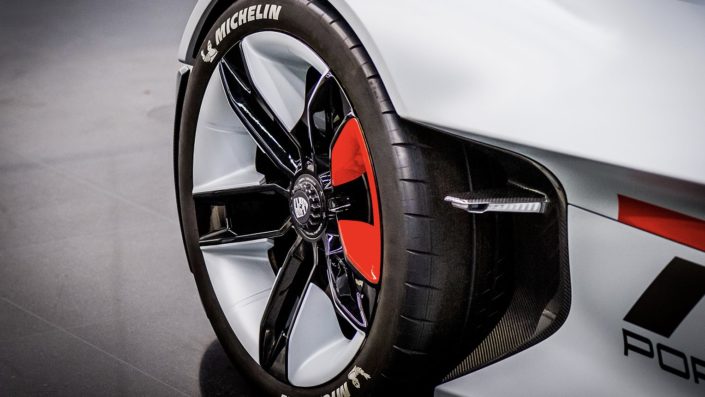Porsche está presente en la serie de videojuegos “Gran Turismo” desde 2017. Entre sus modelos más recientes figura el Taycan Turbo S. Para el lanzamiento de la séptima entrega de la saga, Porsche, por primera vez, ha desarrollado un vehículo exclusivo para el mundo virtual.

Porsche Vision Gran Turismo, el coche de carreras virtual del futuro
El Porsche Vision Gran Turismo es el primer concept car del fabricante de automóviles deportivos creado de manera específica para su uso en juegos de ordenador. Se podrá ver únicamente en el Gran Turismo 7, que se lanzará al mercado el 4 de marzo de 2022 para PlayStation 4 y PlayStation 5.
Al asociarse con Polyphony Digital Inc., Porsche muestra su enfoque futurista y demuestra una vez más el alto nivel de experiencia de sus diseñadores, quienes, liberados de las limitaciones que impone la producción en serie, han podido dar rienda suelta a sus ideas a la hora de crear un prototipo para el videojuego.
“Un vehículo diseñado exclusivamente para el mundo virtual nos abre posibilidades emocionantes que, de otro modo, están fuertemente reglamentadas en un automóvil de fabricación en serie”, dice Michael Mauer, Director de Diseño de Porsche. “Proyectos como el Porsche Vision Gran Turismo son especialmente valiosos para nosotros en el proceso creativo. Desarrollar aún más nuestro ADN Porsche claramente definido e intercambiar opiniones con diseñadores de otras industrias es una parte importante de nuestro trabajo”.

Elementos de diseño tradicionales orientados hacia el futuro
El Vision Gran Turismo presenta rasgos de diseño de Porsche que resultan familiares, aunque con una clara orientación al futuro. El concept car exhibe las proporciones típicas de la marca, con una relación altura/anchura especialmente deportiva, un capó extremadamente bajo y unos pasos de rueda muy pronunciados. Los faros y las tomas de aire integrados en un frontal purista, crean un vínculo con el lenguaje de diseño del Taycan, en un claro guiño a la conducción eléctrica. En la parte trasera destaca la franja de luz estrecha, que recuerda a la firma lumínica de los modelos 911 y Taycan.
El claro énfasis en la identidad de marca continúa en el interior, con la pantalla de la instrumentación de diseño curvado hecha a la medida del conductor, que parece flotar sobre el volante. La posición baja del asiento pone el acento en el dinamismo, mientras algunas superficies de apariencia realista que definen el habitáculo también juegan un papel clave. “Estuvimos mucho tiempo decidiendo el material adecuado, que al final resultó ser una mezcla de carbono y titanio. El objetivo era reducir el peso y aumentar las prestaciones”, dice Markus Auerbach, Director de Diseño de Interiores de Porsche. “Además, la sostenibilidad es fundamental en cualquier proyecto que mire hacia el futuro. Por eso solo usamos materiales completamente veganos en el concept car”.
“El atractivo de un Porsche proviene de su diseño purista”, dice Kazunori Yamauchi, Presidente de Polyphony Digital. “Y en términos de experiencia en ingeniería, tanto nuestra empresa como Porsche seguimos la misma filosofía basada en la perfección. Compartimos la misma pasión por las carreras y miramos hacia el futuro del automóvil”. Además de los temas puramente relacionados con el diseño, también hay nuevas funciones que contribuyen a que los jugadores sientan la deportividad en sus manos. Por ejemplo, a través de la respuesta háptica del controlador, que imita las reacciones naturales del volante y recuerda, por su rapidez y precisión, a la dirección de un coche de carreras real.

Porsche Vision Gran Turismo, el coche de carreras virtual del futuro
La expansión de las actividades de juegos también tiene un significado estratégico para Porsche. “Podemos situar a jóvenes usuarios digitales en el lugar donde nacen sus sueños automovilísticos: el mundo de los videojuegos”, dice Robert Ader, Vicepresidente de Marketing de Porsche AG. “La asociación con Polyphony Digital y ‘Gran Turismo’ encaja perfectamente con Porsche, porque el deporte del motor, ya sea real o virtual, es parte de nuestro ADN”. La integración del primer automóvil deportivo Porsche desarrollado exclusivamente para el espacio virtual es un hito importante en la asociación estratégica entre Porsche y Polyphony Digital Inc.
Porsche es sinónimo de experiencias auténticas y emocionales. En este contexto, los videojuegos y el mundo virtual ofrecen nuevas oportunidades para hacer que los coches deportivos sean interactivos y que conducirlos sea una experiencia accesible. Por esta razón, la marca ha estado cooperando con varias empresas de la industria del videojuego durante varios años y estas actividades son ahora una parte integral de sus acciones de marketing. El objetivo primordial es crear una experiencia de marca duradera.
Acerca de Gran Turismo™
Gran Turismo™ es un videojuego desarrollado por Polyphony Digital Inc., subsidiaria de Sony Interactive Entertainment Inc. Lanzado en Japón por primera vez en 1997, está considerado como el mejor y más auténtico simulador de conducción debido al realismo de sus gráficos, a la tecnología que reproduce la física y al cuidado por el detalle. Polyphony y su famoso creador Kazunori Yamauchi han revolucionado el género de los juegos de carreras.



















